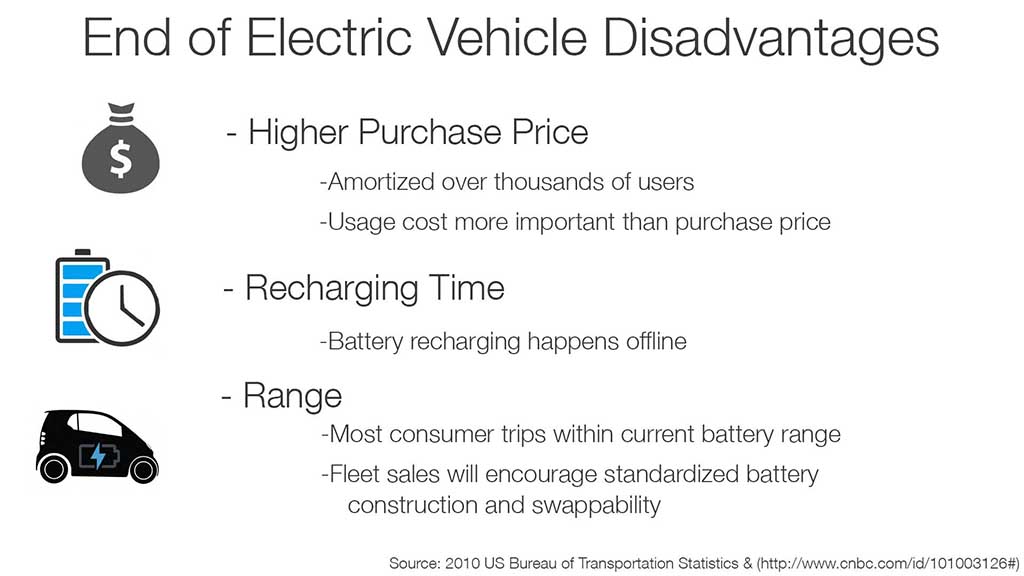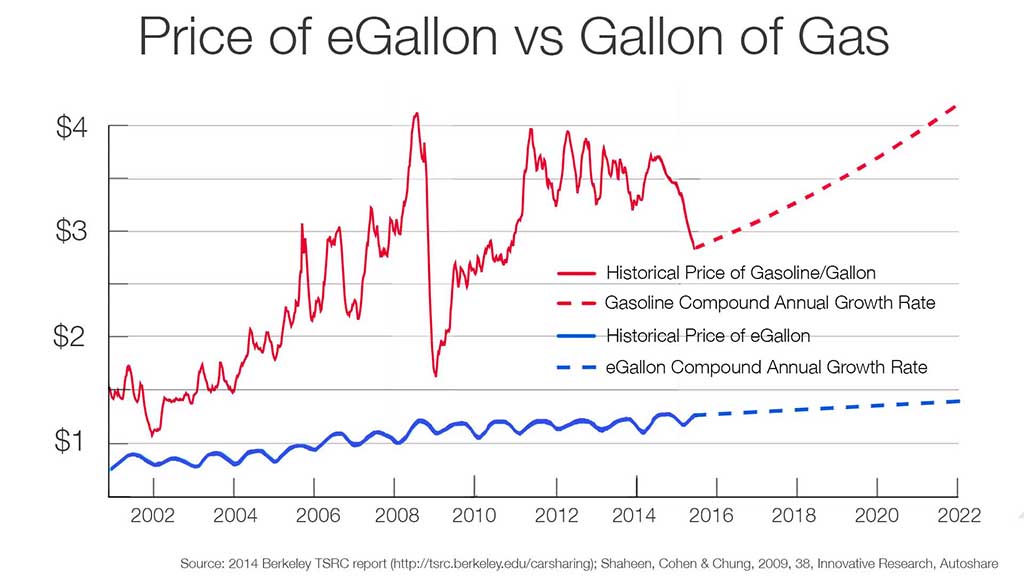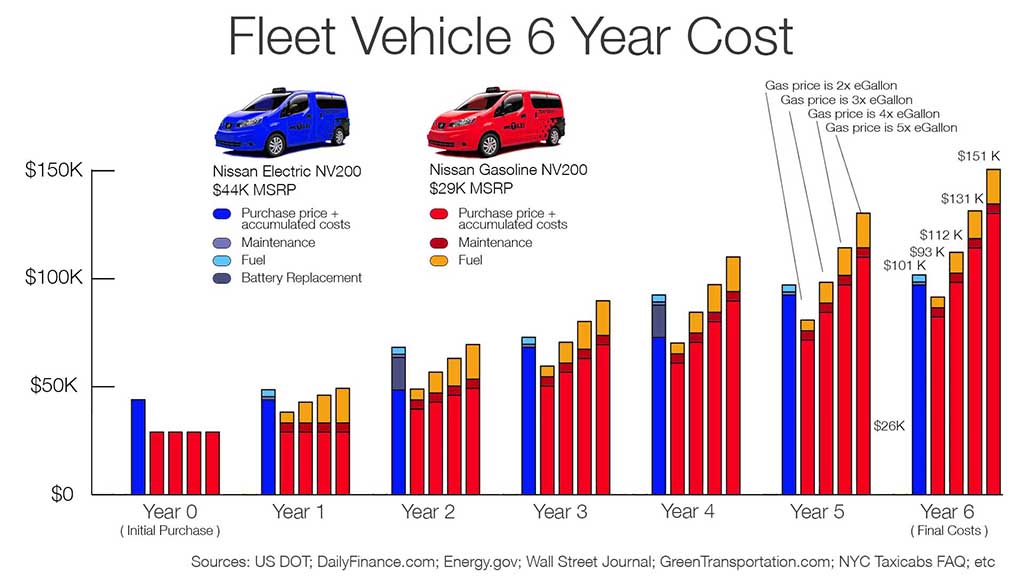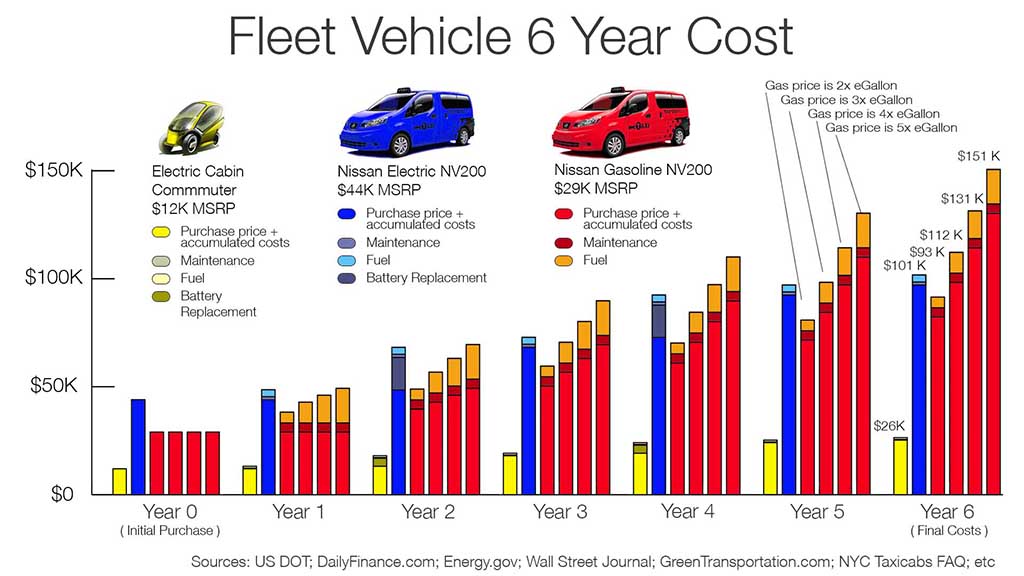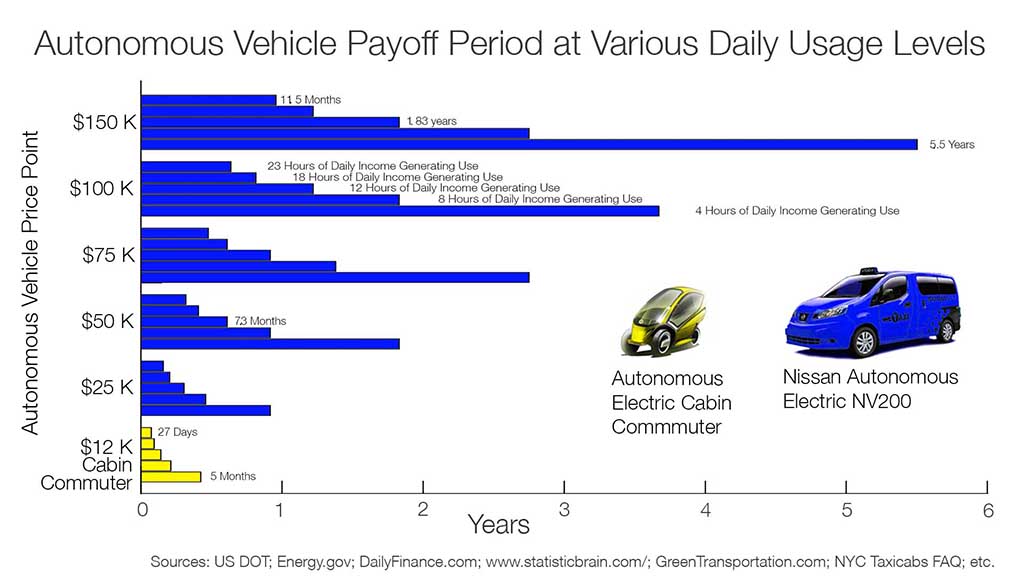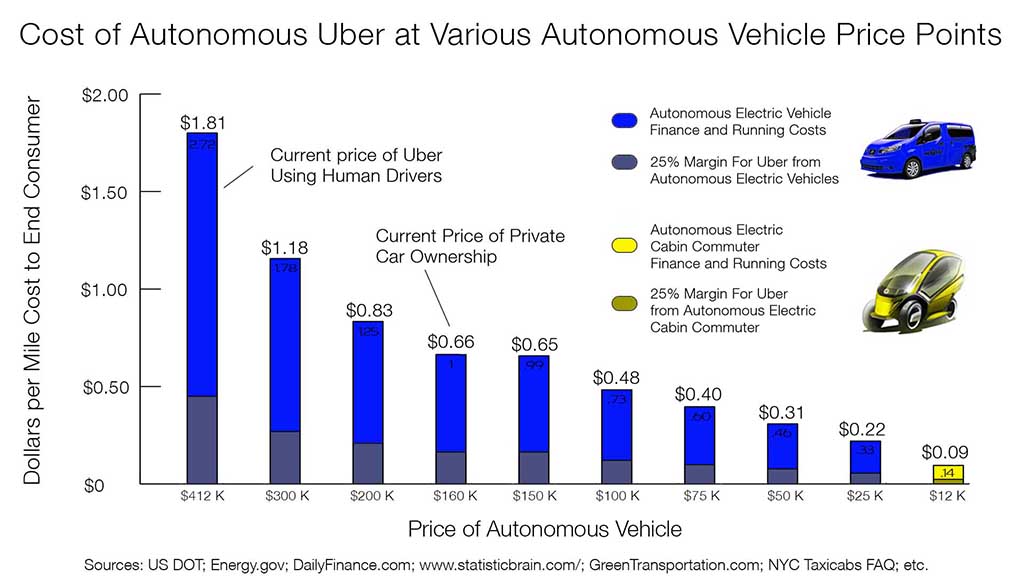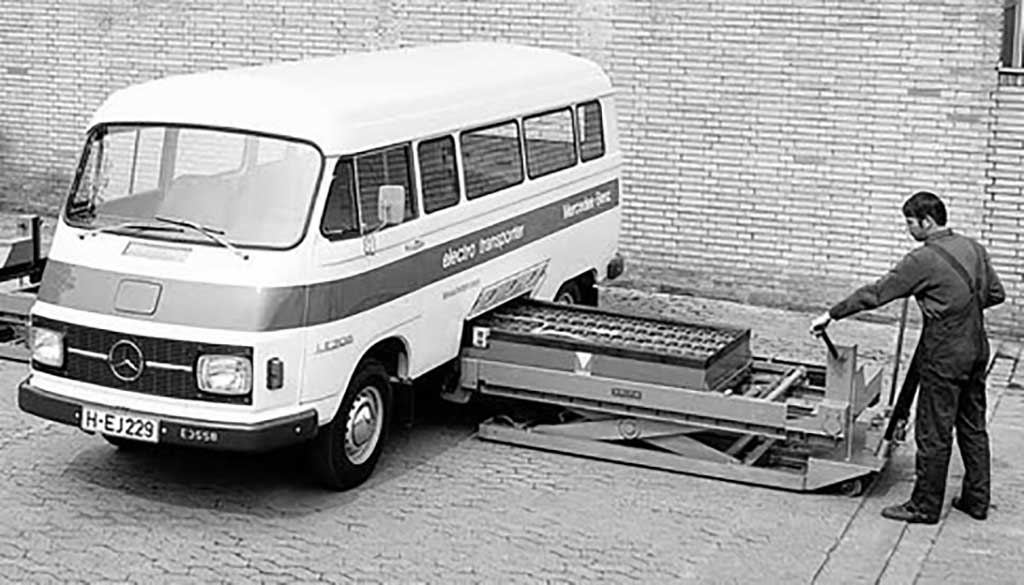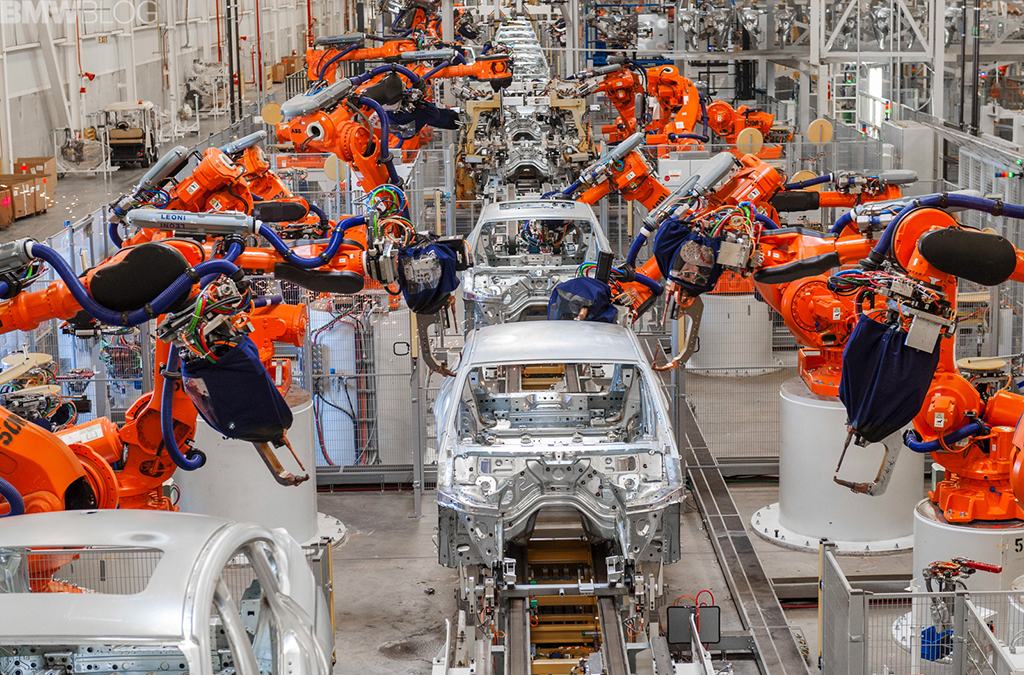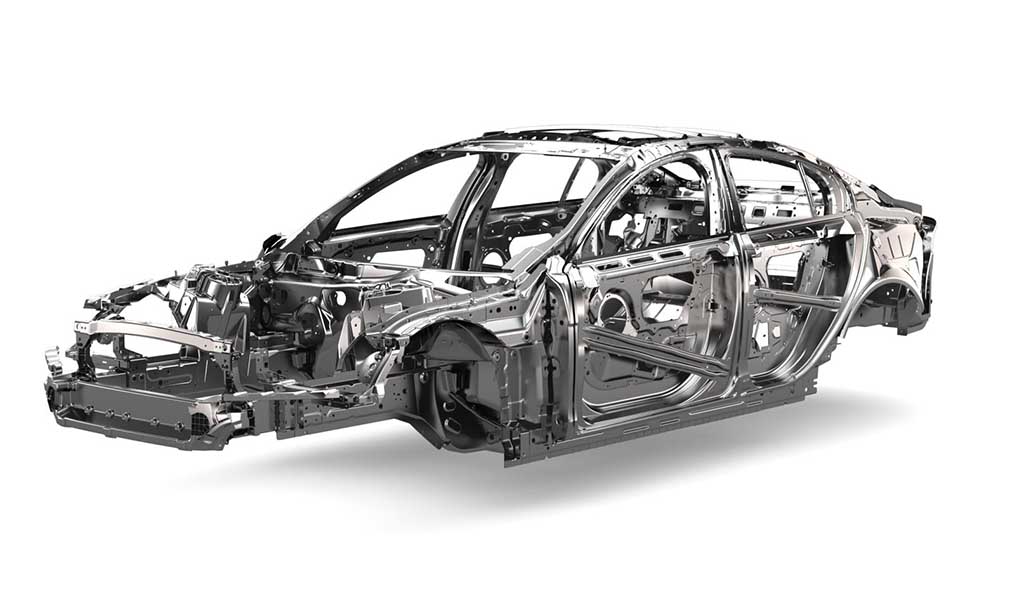Blog
End of Gas Cars
The big winners in this disruption are going to be electric vehicle manufacturers because the reality is that 95% of the trips people take in cars can be handled by electric vehicles equipped with current battery technology1 and the three main drawbacks of electric vehicles (initial purchase cost, range and recharging time) will all be negated by The Mobility Cloud.
The moderately higher purchase cost of an electric vehicle will be become inconsequential because in this usage model, now the vehicle’s purchase price is being amortized over tens of thousands of users over the useful life of that vehicle and that modest difference in initial cost becomes irrelevant. Keep in mind these shared vehicles are now operating as cabs and consequently will be doing ~70K miles per year2 rather than the 13.5K miles per year3 that private automobiles do on average. So what matters now is running costs, and running costs for electric vehicles are so much lower than gas vehicles that in terms of real dollars to the consumer and fleet manager, the electric vehicle will be much cheaper to operate than gasoline vehicles.
The charging time problem is eliminated because the consumer is only using the vehicle for the duration of one trip. He doesn’t have to worry about how long it takes for the battery to charge offline because the consumer has no exposure to that. The consumer won’t even be using the same vehicle for his return trip. The range problem is also largely eliminated for the same reason as the charging time problem. As long as the consumer’s one way trip is within the range of the electric vehicle, and 95% of trips4 fit that profile, range doesn’t affect the consumer. The range and the recharging time are the fleet provider’s responsibility to manage, not the consumer’s. So there’s now a situation where not only has The Mobility Cloud removed the primary barriers to consumers choosing electric vehicles, but electric vehicles are now able to significantly undercut gasoline vehicles fiscally almost from day one, which has never been the case before.
There’s no need for subsidies or incentives to sell electric vehicles anymore because they’re economically and functionally superior to gasoline vehicles on their own. It’s easy for naysayers to claim that will never happen because electric cars only constitute less than one percent of the market and they’ll never catch up, but that’s a linear claim in an exponential system. To see see a more quantitative demonstration of the benefits of electric vehicles in the The Mobility Cloud go on to the next section.
EV Economic Superiority
Electric cars, like solar power, have been a “feel good” technology that for decades couldn’t compete with the more common and environmentally destructive fossil fuel alternatives without the aid of subsidies. That’s all going to end. The economics of on-demand transportation will fiscally favor electric vehicles and if gas prices rise back up (I’m writing this in mid-2015) to the level they’ve been at for the past 5 or 10 years then electric vehicles will be massively more advantageous. It’s meaningless to discuss the cost competitiveness of gas vs. electric power without first understanding the relationship between a gallon of gasoline and an eGallon, which is the electrical energy equivalent of a gallon of gas. See this slide that describes the historical relationship between the price of a gallon of gasoline and the price of an eGallon.
What we learn from this is that the price of electricity is extremely stable and predictable, and it’s even seasonably predictable. The price of gas, however, is completely unpredictable. It varies roughly between 1.5x and 4x the price of electricity on national average. This means that it doesn’t really make sense to analyze the cost effectiveness of electric vehicles in terms of just one fixed ratio of the price of electricity to the price of gas. In light of this, I’ve analyzed the economics of a gasoline vs. electric fleet vehicle in this slide at several different multiples of how much gas costs relative to electricity.
Even with having to replace the batteries in the electric vehicles every 150K miles, they still have cheaper running costs than gasoline vehicles at any multiple of gas prices more than about 2x the price of electricity. And don’t forget that gasoline engines are an ultra-mature technology that has benefitted from over a century of optimization. Electric vehicles are a very immature technology that have lots of room for improvement and growth. I would call the Tesla Model S, BMW i3 and any other current generation purpose-built electric vehicle version 1.0 of electric vehicle technology. I consider the Tesla Roadster, Nissan Leaf and any other EV that’s a derivative of a gasoline design the beta release of electric technology and I consider the GM EV-1 to be more the prototype phase of electric vehicle technology.
I mentioned that this analysis is budgeting for the replacement of the batteries every 150K miles (roughly every two years). The more we learn about the longevity of Tesla’s Roadster and Model S batteries, however, the more we learn that that estimate might be conservative and perhaps it might not be necessary to change the batteries that often, which means the electric advantage would be even greater. This page describes an electric vehicle’s fiscal competitiveness with gasoline technology, but keep in mind that the thrust of this web page is describing how single occupant vehicles are going to become the dominant automotive architecture in the world in the next twenty years. These vehicles will completely disrupt the economics of transportation in the future, as described in the next section.
Overwhelming Economic Advantage of Cabin Commuters
The purchase price and running costs of Cabin Commuters are so overwhelmingly advantageous that they would noticeably reduce humanity’s impact on Planet Earth. Start by taking a look at how the purchase and running costs of an electric Cabin Commuter stack up against those costs for full size electric and gas vehicles that we discussed in the previous section.
If you want to know what the economy of this minimal platform does to the economics of shared transportation, take a look at this payoff chart. This is the exact same chart I showed you earlier in the Uber Will Change the World section except that the Cabin Commuter has been added in.
This is the payoff period for a Cabin Commuters with fully amortized and mature autonomous technology manufactured in huge quantities. If an autonomous Cabin Commuters is put to work 23 hours/day it would pay itself off in 27 days. Even if it was only used four hours/day it would still be paid off in five months. Even with minimal usage it would still spend five and a half years of its useful life just generating profit relative to the human labor rate.
If anyone’s curious to know what this does to the price of transportation through The Mobility Cloud, take another look at the cost graph I showed you previously in the The Mobility Cloud section.
This graph shows us that using a technologically mature, mass produced autonomous Cabin Commuter could reduce transportation costs below ten cents/mile. That’s roughly an 85% decrease in the price of transportation relative to private car ownership. By my calculations that’s about three trillion dollars of disposable income saved just in America. Imagine what consumers could do with all those freed up funds.
Finally, if Uber and its ridesharing competitors reduce the price of wheeled transportation by 85% relative to the current price of privately owned cars through The Mobility Cloud, what do you think that’s going to do to the global market for transportation? There’s going to be billions of new customers for transportation in the developing world, and 75% of these new customers are going to be riding around in Cabin Commuters.
So we could debate all day long about consumer choice and marketing and will Americans really accept riding in these small Cabin Commuter vehicles, but at the end of the day, the underlying physics, which will create the macroeconomic forces that will drive consumer choice, combined with the point to point convenience of these vehicles, all ensure that these Cabin Commuters cannot be beaten by any other mode of transportation, even public transportation.
That’s why this humble little machine will be the Walkman and the iPhone and the Facebook of the coming autonomous vehicle revolution.
Swappable Batteries?
Most vehicles sold in a world of on demand autonomous transportation will be fleet vehicles, not privately sold vehicles. That means it’s much easier to mandate standardized battery construction, installation and infrastructure, which means that now swappable batteries are much easier to implement, unlike in the case where most sales are to private consumers, who demand a myriad of options and customization which makes standardization more challenging. Depending on how fast quick charging can or cannot be optimized, it may be in the fleet provider’s financial interest to pursue standardized, swappable batteries because that way when they have to recharge a vehicle it only takes the battery pack offline for the duration of the charging time rather than the entire vehicle. Swapping a battery large enough to power a full size vehicle isn’t as easy as swapping the batteries in a flashlight, though.

It’s more like this difficult.

Swapping batteries in a full size car is an engineering burden that inherently adds significant cost and complication to any design, but even more onerously, requires a national infrastructure of swapping stations. Charging an EV’s battery also requires a national charging infrastructure, but the hardware for charging is much, much less than what is required for mechanically changing batteries. This is why many people say that in an era of thirty minute fast recharging there will never be any need for swappable battery packs. That’s a reasonable argument, and it’s especially relevant to the private consumer market. But all that being said, here are some interesting numbers to consider.
If an autonomous cab can fast charge in 30 min that equals $9.90 of income lost at the present human labor rate. If it charges 6x day that’s $59.40 lost each day. In a year that vehicle loses $21,700 of income from charging time. If a ride sharing provider like Lyft or Uber or Sidecar has a million vehicle fleet that means $21.7 Billion in lost revenue in one year across that fleet. Over the 6 year life of the entire roboUber fleet that equals $130 billion. If the vehicle has a swappable battery that can be changed in 5 minutes that means $3610 of income lost annually per vehicle. With the same million vehicle fleet that equals 3.6 billion in lost revenue. Over the 6 year life of the roboUber that equals $21.6 billion. So a swappable battery system would save a ridesharing company with a million vehicle fleet over $108 billion dollars during the six years between fleet turnover, which is a staggering amount of money.
Once vehicles have swappable battery packs (which I’m not necessarily convinced will happen, btw), now the long distance market isn’t left to gasoline vehicles anymore, because mechanically swapping a battery in the middle of a long trip won’t take any longer than gassing a combustion-engined car up does right now. We already have the national real estate infrastructure available to handle this in the form of current gas station locations.
Tesla made a well publicized effort to include the capability to mechanically swap batteries in their Model-S and that program was a failure for numerous reasons. Chief amongst the problems was that Tesla wanted the consumer to return to the swap station to reclaim their privately owned battery, which is potentially a major hassle for the consumer. Swapping batteries isn’t just mechanically challenging in a privately owned vehicle, it’s also logistically challenging. Does the company require the car’s owner to come back and reclaim their own battery? If not, the alternative is that the car company basically has to give away an eternally renewing version of the most expensive part of the electric car (the battery) in perpetuity, which is great for the consumer but not so great for the car company trying to watch their bottom line. With a fleet of commercially owned electric vehicles, the technical problems of swapping batteries are simplified (but not erased) but just as importantly, the logistical problems are almost completely eliminated. The inherent conflict between the consumers’ and manufacturers’ best interests is erased when the fleet operator owns all the vehicles, the batteries and the swapping stations en masse.
Also, a Cabin Commuter’s battery will be just a fraction of the size of a full size vehicle’s battery- probably less than a quarter of the mass. So even if fast charging never gets faster than ~30 minutes (which is unlikely it won’t improve) that means the Cabin Commuter could recharge in 7.5 minutes with equivalent hardware. A vehicle that fast charges that quickly doesn’t have any need for swappable batteries.
So the takeaway is that swappable batteries probably don’t make sense in a world of consumer owned electric vehicles, but don’t count that technology for full size vehicles out in The Mobility Cloud. But also don’t expect small Cabin Commuters to ever have swappable batteries.
Decimation of Private Car Sales in America
As more and more consumers choose to use The Mobility Cloud for their transportation needs rather than privately owned vehicles, the market for private car sales in industrialized nations and any other market that’s currently at “peak car” will be gutted. This will happen gradually over the course of several decades. This will also result in the collapse of the used car market in these same markets. Most car sales in industrialized nations will be fleet sales and the total number of cars sold will likely be only a fraction of current sales volume.
How much will sales go down? No one knows for sure but estimates range from Barcley’s suggesting “only” a 40% drop1 to PricewaterhouseCoopers claiming a 99% decrease2 in sales. The wide range between those two estimates suggests the difficulty in quantifying this disruption, but either scenario is an economic disaster for the automobile manufacturing industry. So is this the end of the car manufacturing industry as we know it? Will the automobile industry be just a shadow of what it was in the decades prior to and following the millennium? I think not. See the next section for reasons why the automobile industry may not have reason to fear, and indeed, may be able to grow to levels never before seen as long as they can embrace change and restructure their business quickly enough to produce different product.
Transportation Explosion in the Developing World
This section should really be titled, “Explosion in transportation in the developing world and consequent salvation of the automobile manufacturing industry.” The Mobility Cloud can’t usurp private car ownership as the consumer’s dominant method of interacting with the automobile unless it’s less expensive than private car ownership, and it has to be meaningfully less expensive to have a real impact. Consequently, by definition, if automobile sales are devastated in the industrialized world that means that The Mobility Cloud is offering transportation significantly cheaper than privately owning cars. If the cost of transportation is reduced by twenty or fifty or eighty percent, the inherent corollary of the previous point about car sales being gutted in the industrialized world is that the price of transportation will have been reduced so much that now it’s available to a significant percentage of the human race living in the developing world that could never afford it previously. Billions of people in the developing world are doing this right now to get around.
All of these people, and there are literally billions of them, would choose to ride in or on a vehicle if it were available to them and affordable, and if the price of transportation drops to a fraction of its current cost through The Mobility Cloud, it will be affordable to many of them. Industrialized nations are already at “peak car,” but developing nations are very far away from peak car, so there is room for huge increases in the transportation user base in those markets. This growth in transportation in developing nations is the only thing that will keep current established automobile manufacturers in business, but they’ll only stay in business if they can adapt fast enough.
To survive, existing automotive companies will have to transition from manufacturing the gasoline-powered, consumer-oriented vehicles they’re currently producing to building electric fleet vehicles, intended to be owned by multinational ride service providers like Uber and its future competitors. These fleet vehicles will have greater standardization, fewer options and most won’t be the ultra-luxurious consumer items that car companies are spitting out by the hundreds of thousands of units right now. Highly luxurious, on-demand transportation will certainly be available for those that want to pay for it, but it won’t be the primary market.
The developing world will skip the cultural phase of widespread, massive private car ownership that industrialized nations went through. It will be like SE Asia and many parts of Africa were with telephone technology. Those societies never installed land lines on a massive scale like Western Europe and America because by the time the population economically could afford and needed mass phone penetration mobile phones had already arrived. They never did land lines. Developing nations will have a whole social class that never experiences private car ownership as they climb the socioeconomic ladder.
End of Public Transportation
The graph shows the amount of energy required to move a human body around by various modalities, expressed in BTUs/passenger mile.
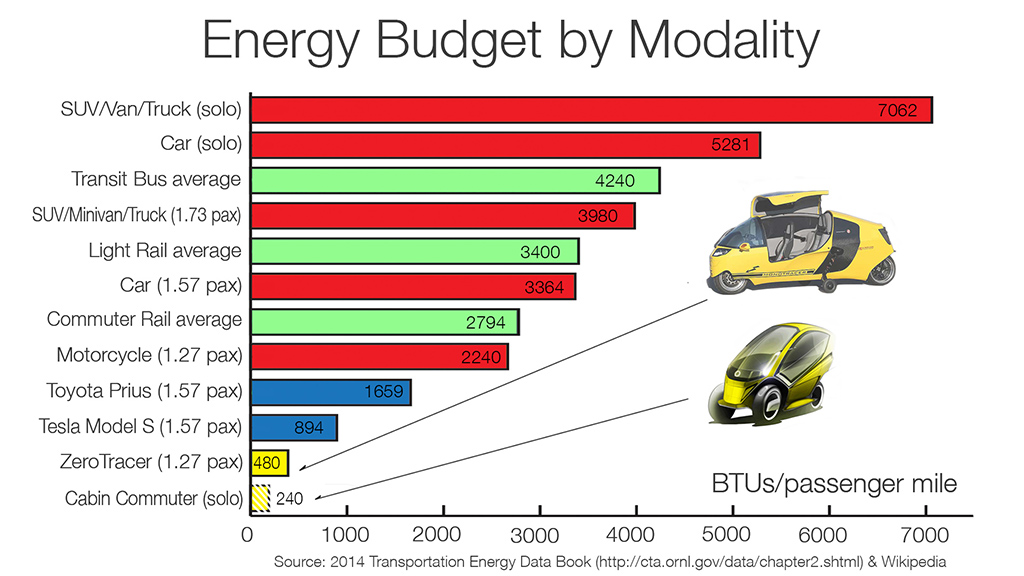
This efficiency measurement is environmentally relevant, but the real reason I’m sharing this information is because it directly reflects the true cost to the end consumer of each option, absent of subsidies. That BTU measurement might as well be dollar signs. In fact, let’s convert it to dollars and cents.
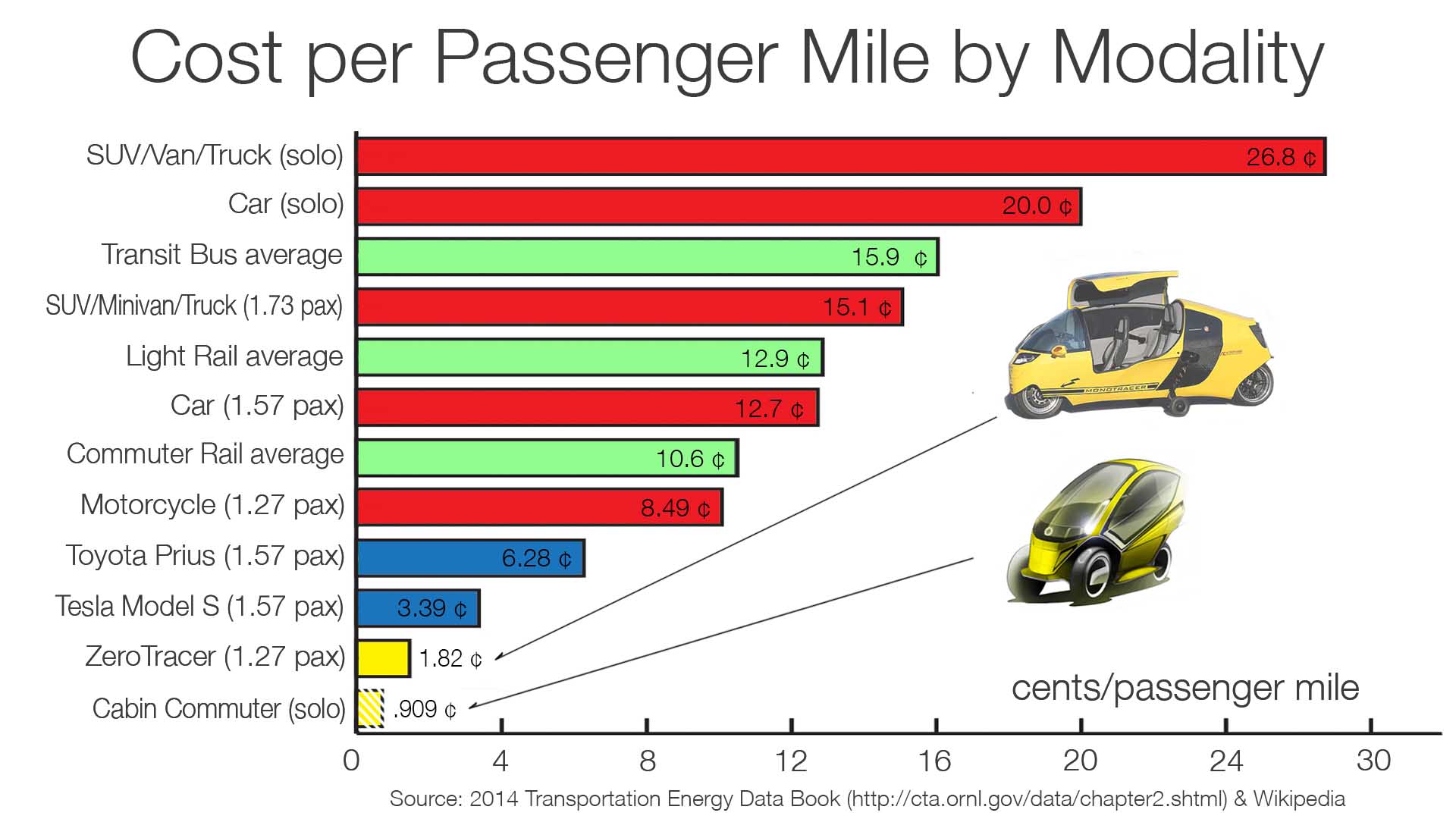
This is the exact same graph but with BTUs converted to dollars, expressed in cents/passenger mile. Everything in red is a traditional gasoline powered automotive product. I should caveat that the top two entries are gasoline cars and SUVs at solo occupancy because that’s the most numerically common way to commute. Everything below the top two entries are listed at national average occupancy and so are directly comparable to each other. Continuing on, the green entries are public transportation and the blue entries are prominent hybrid and electric full size vehicles. The top yellow entry is the Peraves ZeroTracer/X-Tracer, the electric Cabin Commuter vehicle that won the Progressive Automotive X-prize in 2010. Don’t forget, however, that that vehicle was an electrically retrofitted, 35 year old gasoline design that’s twice as big as what we want for transporting a single passenger in a truly efficient manner. A smaller, purpose-built electric vehicle like what I described in the Cabin Commuters are the Answer section could easily cut the Peraves ZeroTracer/X-Tracer’s efficiency number in half.
Taking a look at the big picture, it’s not really a surprise that the Cabin Commuter is more efficient than the full size vehicles. What is surprising about this graph is learning just how truly energy inefficient public transportation is in America. It isn’t any better than private car use.
Now, if we were going to make public policy decisions based on actual energy use, then the logical conclusion to that is that the government should stop investing in legacy public transportation and invest in, and even subsidize, these small Cabin Commuter vehicles because Americans would get such greater return on their money. Now, the social progressive in me is quite uncomfortable advocating that we cease investing in public transportation, but the US Transportation Energy Data Book doesn’t lie and the underlying physics is not sympathetic to my social values.
Finally, don’t forget, Cabin Commuters are point to point, which is something that public transport in its current form can never accomplish. Consequently, we can debate all day long about consumer choice and marketing and will people really accept riding in small Cabin Commuter vehicles but at the end of the day, the underlying physics, which will create the macroeconomic forces that will drive consumer choice, combined with the point to point convenience of these vehicles, all ensure that these Cabin Commuters cannot be beaten by any other mode of transportation, even public transportation.
Automotive Design Changes
Automobile design is going to go through the greatest evolution since the advent of the car. There’s too much to discuss in detail here, but here’s a couple of things to consider. For multipassenger cars the design will change so that now all the seats will likely be arranged facing each other like seats around a coffee table, and some cars will even have a coffee table in them! Secondly, right now cars are built like scaled down military tanks because they are built to survive smashing into a brick wall at 30 mph. In essence, the safety is built into the hardware. In an autonomous world, though, the safety will be built into the firmware. There won’t be any need to have vehicles that are tanks anymore because they will be very close to crash-proof through the control software. Cars will be more comfortable and human-friendly, but under the skin they will be more like scaled up golf carts rather than the scaled down tanks we’re currently buying.
Those endgame questions are very interesting to me. Cars will be featherweight structures that are just strong enough to support the battery mass for an acceptable vehicle lifespan. They will still be, from the user’s perspective, an acceptable to very luxurious experience depending on the user’s budget but underneath they will be scaled up golf carts. No airbags, no crash structure, etc.
Right now all the safety in a vehicle is built into a vehicle’s hardware. As I mentioned, cars are sort of scaled down tanks.
They’re so safe that a person can literally drive into a brick wall at 30 mph and have a substantial chance of walking away from the accident and going to lunch afterwards. That’s sort of an engineering miracle in my opinion. But once we have autonomous vehicles that meet society’s standards of safety, the safety will be built into the firmware rather than the hardware. And that firmware safety will likely be at least 99% better than the hardware safety currently available to us. Once the firmware safety is 99% better than the hardware safety we’re currently enjoying, there’s really no need for the hardware safety anymore. We won’t need eleven airbags, a thousand dollars in inertia sensors and eight hundred pounds of structural steel. it would be easy to halve the weight of the car, which would have a profound positive impact on battery range and energy policy, among other things. But that’s the engineer’s analysis of the situation. The complication with this is that we live in a media culture rather than a society of engineers, so it won’t just immediately implement just because that’s the best engineering solution. In order to make the transition from hardware safety to firmware safety, it requires a politician at some point to stand up and, to some people’s ears, effectively say, “I think we should make cars less safe.” This is a politically suicidal statement on the level of, “I want to raise taxes” or, “I hate children.” Pardon the hyperbole, but that’s sort of what what we’re dealing with in terms of public perception. This is why we have car/booster seat laws until kids are 8 years old despite the fact that statistics show that car seats offer no additional safety after the age of 2 relative to a properly belted child. So, if we were all engineers in this society, all the crush standards for cars would quickly be abolished for production autonomous vehicles, but we’re not all engineers. Our society is made up of fallible human beings subject to hugely powerful emotional objections like being afraid that their kids will be killed in car accidents. I often wonder what will happen when the overall vehicle safety rate approaches the current school bus safety rate. Will we still be building scaled down tanks? Or will we start building scaled up golf carts? I’m not sure the latter is a foregone conclusion.
New Vehicle Architectures
There will be many new vehicle architectures that will appear, all enabled by autonomous technology.
Single Occupant Enclosed Trikes/Quads
This is the Cabin Commuter to which I’ve devoted this website. This will be the most common and ubiquitous vehicle form factor in the world in twenty years.
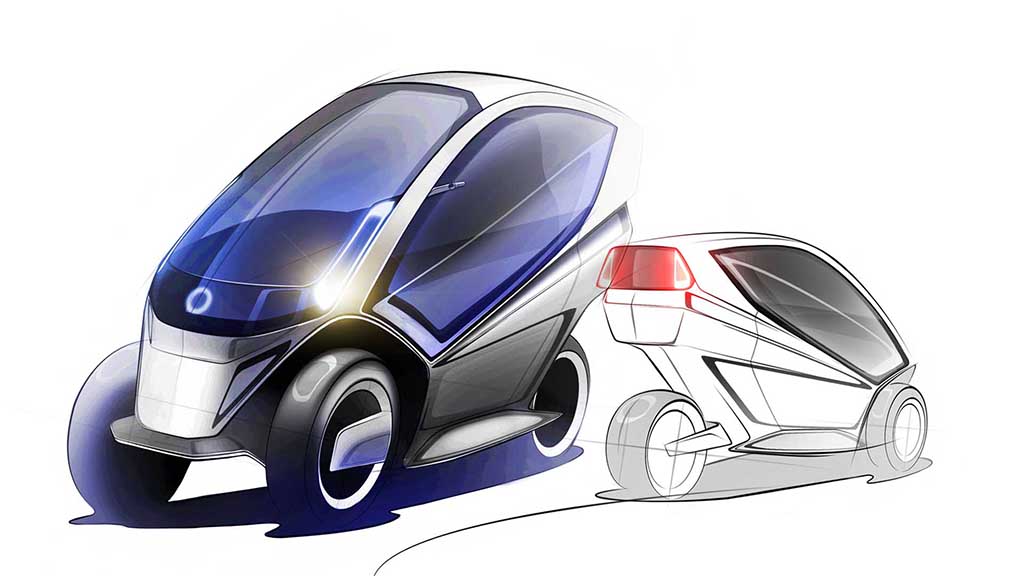
Small Group Taxi
These will be vehicles for 2-6 passengers that will be used for carpooling and family trips, starting with something small like the Smart Cars that can currently be seen on public roads and going up to vehicles with multiple rows of benches or captain’s chairs like a contemporary minivan. These will be most like the vehicles used today.

Sleeper Cabs
This might literally be not much more than something like an enlarged coffin on wheels that has just enough space for a person to lay down in or sit up on a twin bed mattress and is designed for overnight human being delivery. There will be queen bed sized and other versions as well.
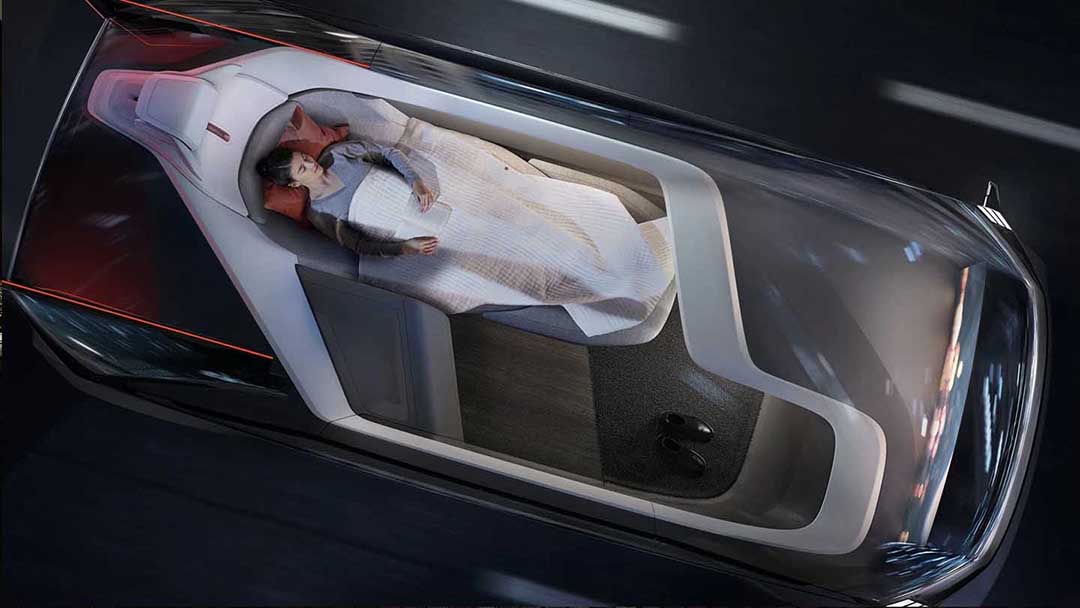
Mobile Office
This will be a work desk/chair setup that will become what all realtors, contractors and similar professions work from. They will range from tiny single seat/small desk arrangements up to larger setups with guest chairs and coffee tables and attached lavatories. This vehicle form factor will be the last holdout for mainstream privately owned transportation because many users will have their professional lives so integrated into the vehicle that it won’t make sense to share it through The Mobility Cloud.
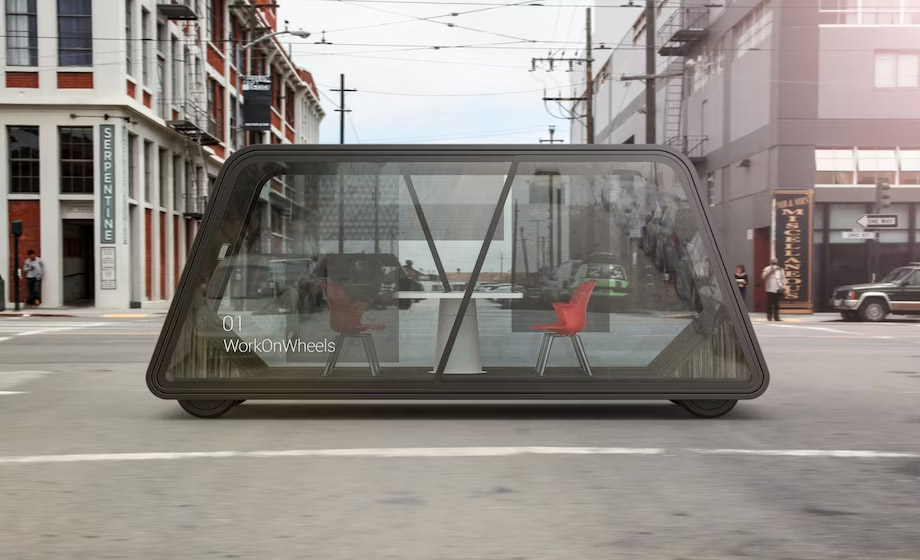
Studio Apartments
This will be a small livable facility with a basic bathroom and kitchen that is like a contemporary bare minimum RV.
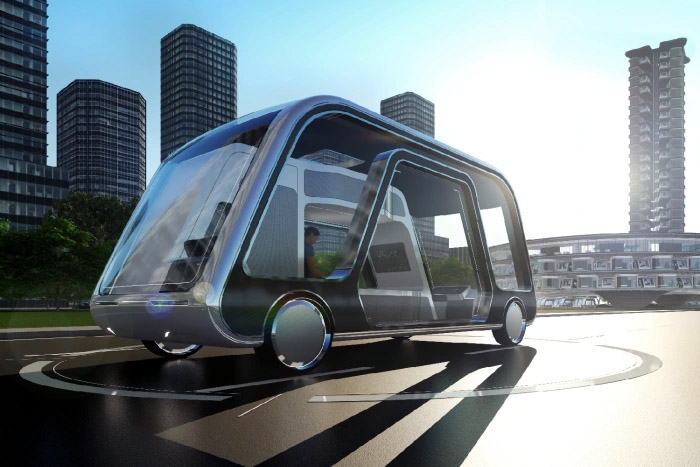
Larger Apartments
Every size/spec of RV imaginable beyond the previous entry will be available up to the point of vehicles the size of contemporary articulated tractor trailers, although the larger ones will be rare in the way that million dollar coach buses are rare today.
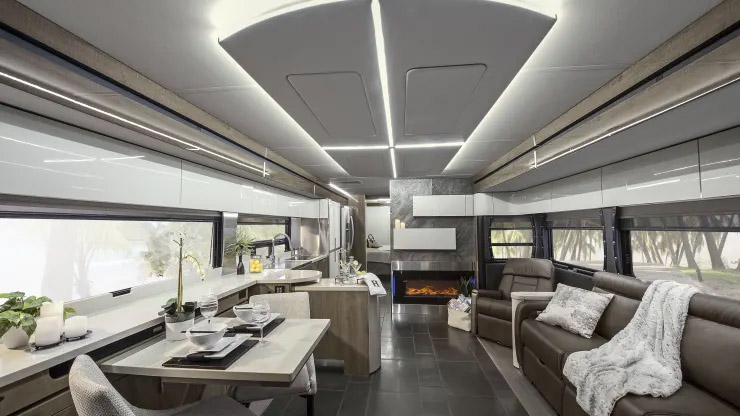
Outlier Vehicles
The entries immediately above will range up to giant mobile homes that can be constructed together at a destination to make a residence that consists of thousands of square feet of usable living space. There are some people in the world that can afford this, and if they want it, it will be available for their use.
This list is far from exhaustive and includes some vehicles that are similar to what’s out there today, but I’m fascinated by how our relationship to the car will change. It won’t be transportation anymore per se for some people, it will be mobile living. All these new vehicles and I haven’t even started discussing vehicles that are designed to carry things other than human beings, like groceries or retail purchases. The future is a wide open, diverse and exciting place!
Mobility Cloud Holdouts
When I say autonomous vehicles will “end private car ownership” what I mean more specifically is “end private car ownership as the primary and dominant modality of using cars.” Not everyone will embrace The Mobility Cloud. These will be just some of the holdouts.
- the wealthy
- rural residents
- automobile enthusiasts (although many of these people will use the mobility cloud in addition to owning a vehicle that interests them. The mobility cloud will be the end of the “daily driver” as it’s referred to these circles. I fall into this group, actually.)
- people that just absolutely have to have their golf clubs, rain jackets, tools, etc in their car with them at all times
- just about all tradesmen and anyone else that has to have their work resources in their vehicle with them at all times (this is an extension of the point above, but for reasons of professional necessity rather than personal preference)
- control freaks that aren’t comfortable being driven around by a machine
- conspiracy theorists, privacy enthusiasts and other subscribers to various versions of the belief that the level of “Orwellian” potential inherent to The Mobility Cloud make it untenable as a consumer option
- people that would like to commit crimes at the destination of their journey or whom have just committed a crime
- public figures that both would like to engage in activities judged to be socially unacceptable (like having an affair) and have a fear that the privacy promised by the autonomous fleet provider won’t be maintained either through omission or commission

